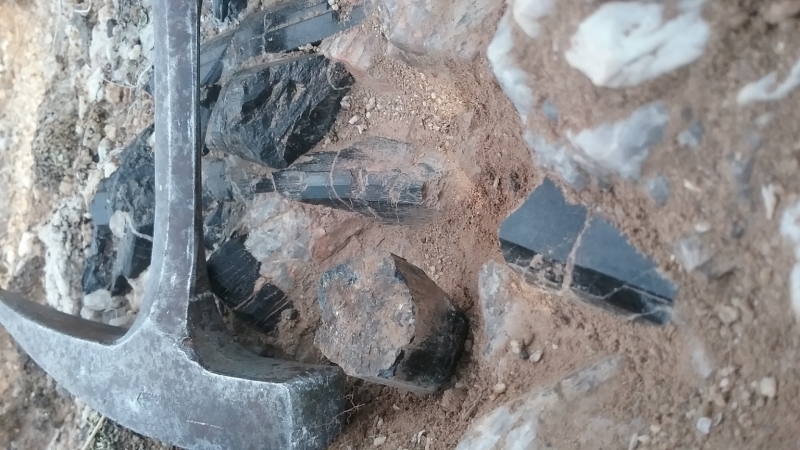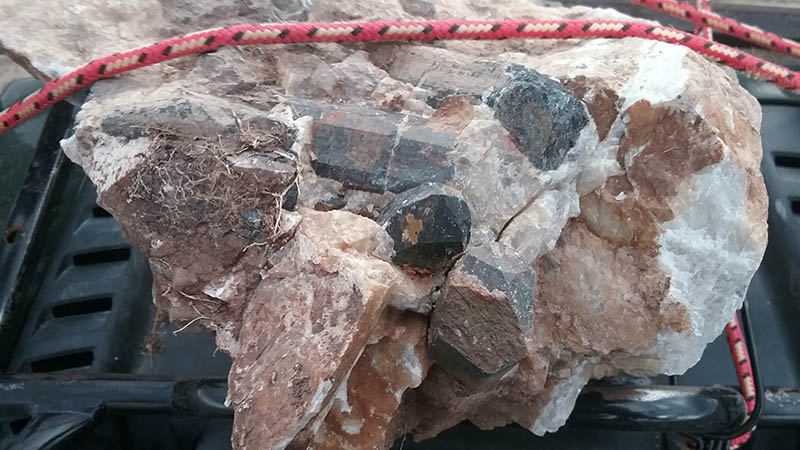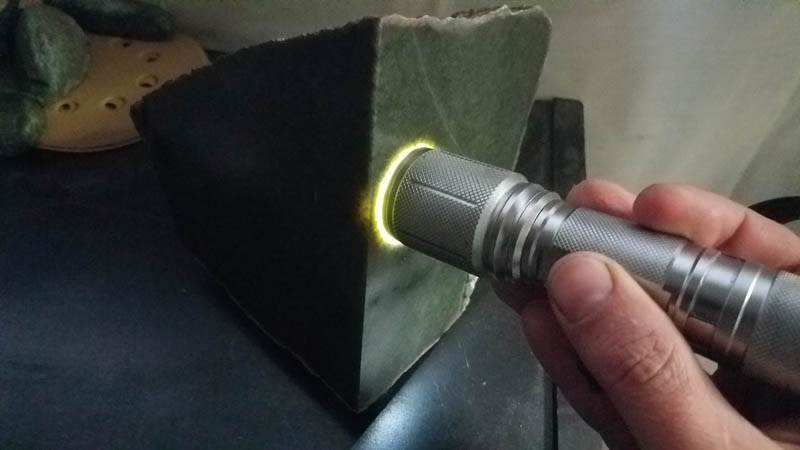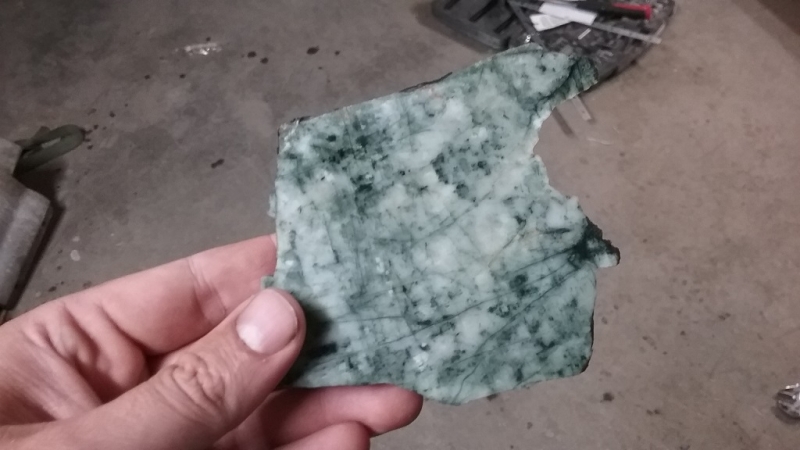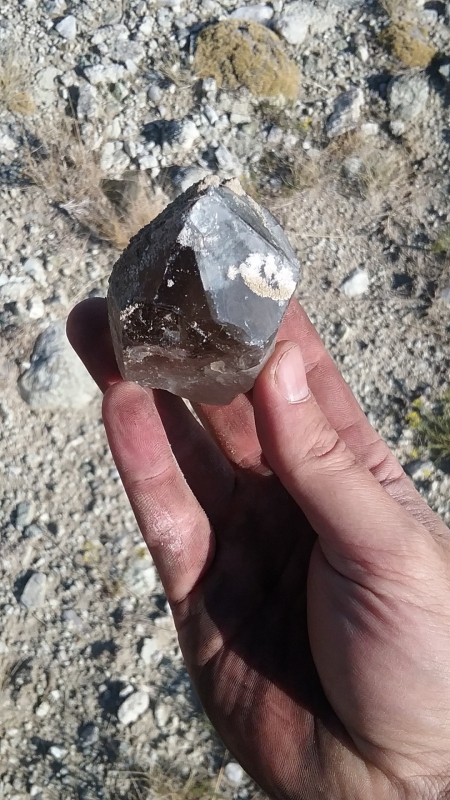-
Posts
2,465 -
Joined
-
Last visited
Content Type
Forums
Detector Prospector Home
Detector Database
Downloads
Everything posted by jasong
-
Nice, those topaz have to be pretty valuable Glenn? The thing I haven't figured out yet with minerals is how to sell finds, with gold we always have the refiner in a pinch. Ebay takes so many fees though and seems like stuff can be listed forever without selling... AU_Solitude - whereabouts in Wyoming were you? I'm in Central. Lots of arrowheads and stuff, not quite as many as I remember finding out here when I was a kid though. I keep finding these old homesteads and thinking man I'm probably the first person out here in 30 years so maybe the first to detect them...haha but I should know better.
-

38 Ounce Nugget Find In U.S.
jasong replied to Steve Herschbach's topic in Detector Prospector Forum
Hmm, nice piece. That doesn't look like Arizona/California desert gold to me though. Mexico? Edit - http://www.minelab.com/usa/go-minelabbing/success-stories/gold-nugget-found-in-mexico reverse image searched it, looks like it was posted in November. 1.5 meters? That's 4.9 feet deep...I guess it's published so some fact checking occured, but that sounds a bit unbelievable even with the 19" and that lunker...? Well congrats to the finders either way, nice nugget. -
It feels refreshing to get out and change it up for a bit! It takes me into some different environments that I don't normally visit with gold which is nice. Found a lot of abandoned homesteads to metal detect too.
-
Thanks, you too. Doing any gem/mineral prospecting up there in Alaska?
-
Very impressive! I notice there aren't many coins in there, do you discrim out anything above a penny and just concentrate on digging a lot of likely gold signals mostly?
-
I decided this season to stop full time gold prospecting and concentrate on prospecting for other minerals. I'll go back to gold primarily if dredging restrictions loosen or a machine a league ahead of the GPZ comes out. Here is part of about a 3ftx4ft pocket of black tourmaline (schorl) I found this summer. Can't wait for the snow to melt off to go back and finish removing it. Anyone else out there switching gears from gold into other minerals? It seems to come easier since we use all the skills we learned and built looking for gold just the same as prospecting for other minerals. I was hoping for a while that a good geology and minerals forum would pop up sans all the LRL/dowsing hocus pocus that others include in their forums as "geology", so I'm posting what I'm up to and hoping some others do as well. Also found a number of different nephrite jade pockets, nothing gemmy yet but still some good stuff. And I'm trying to track down the pocket where this big float terminated smokey came from, but no luck yet.
-
I made a fairly comprehensive video on dating sites via tin cans in general, not just coffee cans, last year. If anyone is interested. For some reason it got almost no views but it's a real useful skill to have for research to be able to date the various different kinds of cans you find out there so maybe people outside the gold prospecting realm can get some use out of it?
-

Future Of PI Detectors
jasong replied to Rick K - First Member's topic in Metal Detector Advice & Comparisons
I did, and I emailed you directly, maybe a year and a half ago. -

Future Of PI Detectors
jasong replied to Rick K - First Member's topic in Metal Detector Advice & Comparisons
I would love to read that forum but it says Gmail is on a "banned" provider list when registering. I tried a couple other emails a while back with the same result. -

White's Xventure Kids Detector Being Sold On Ebay
jasong replied to MDCHIEFSH's topic in White's Metal Detectors
Odd strategies abound in the low end market: National Geographic selling a detector for families too, which some may recognize. -
I like the check one place for all posts philosophy too, but I would use the minerals and geology forum if you make it. I hope there is enough interest to get it going strong!
-

Minelab PRO-SONIC Universal Wireless Audio System
jasong replied to Steve Herschbach's topic in Minelab Metal Detectors
JP, would Minelab make something like this along with adding "power pack" capability with just with a generic clip to add whatever battery we choose? Sort of like a Gold Screamer except with wireless capability and the ability to add whatever battery we want. I think the WM 12 speaker sounds way better than plugging an external speaker into my booster pack on my 4500, but I wouldn't buy just a wireless unit if I still had to be tethered to a battery. -

Vulture Mountains Proposed Mineral Withdrawal
jasong replied to Clay Diggins's topic in Detector Prospector Forum
You may be able to prospect on withdrawn minerals but the regulations vary by district since you are no longer prospecting under 1872, you are prospecting "recreationally" under whatever rules the managing field office decides to implement. Sometimes they forbid it altogether, other times they limit equipment to hand tools, other times they require permits, etc. Which is why it's better if the minerals stay within the public domain always. So your ability prospect isn't limited by the mood of whatever BLM field manager takes the position and brings their personal agenda along with them. I had a great place to dredge that was promptly shut down when they hired a new field manager with an agenda to promote rafting and get rid of prospecting (in part due to the GPAA being highly irresponsible in another unrelated area), so it can and does happen quick and there is no legal recourse. -

Covering Ground Vs Going For Depth
jasong replied to Steve Herschbach's topic in Metal Detector Advice & Comparisons
This here is a good point, semantically speaking since we have both US and AUS prospectors here. I see some really astounding stuff coming from Australia that may be average finds for some over there but would be bigger than anything I could ever reasonably expect to find here in the US. I guess to me anything under 1 gram is "small", 1-10 grams is medium, and 10+ grams are big nuggets...I've dug somewhere around 2500 nuggets since I started detecting and the biggest I've ever found is 1.17 ounces, which incidentally didn't happen until last year. For a second point of reference from over here in the US, I spent 9 months living full time in the field in 2015. My total take with a detector was a little over 17 ounces, plus some high quartz specis, that was my 5th (and final) year doing it more or less full time. In Australia I think that'd be kinda average (or even subpar?) results - but over here it's hard to even convince people it's real without being a big name in prospecting. Still, it's not enough to support me, but that's why I am so rigorous about efficiency and maximizing production with my technique. -

Covering Ground Vs Going For Depth
jasong replied to Steve Herschbach's topic in Metal Detector Advice & Comparisons
I'm making a vid right now breaking down the actual field of a mono coil in a finite element analysis program (I'm not to trying to spam I promise, it just happens this discussion coincides with what I'm working on). I can't model anything without axial symmetry since I'm just using a free FEA program so DD and Super D is out of my ability. Anyways, even with a mono coil, i suspect, the "cone" effect isn't as small as some rules of thumb present. it's more like a "U" depending on a number of factors. -

Cost To Develop GPZ 7000 Over $10 Million
jasong replied to Steve Herschbach's topic in Minelab Metal Detectors
I was surprised when I went into Cabela's (a very large outdoor/sporting goods store) in Phoenix a few years back and found gold pans and Minelab detectors for sale, had a little mini aisle just for them. -

Covering Ground Vs Going For Depth
jasong replied to Steve Herschbach's topic in Metal Detector Advice & Comparisons
I think the key is knowing when to go fast and when to slow down. Actual prospecting (exploration) for me is always a fast procedure. Then the first pass over a patch is a fast but somewhat more methodical procedure. Each subsequent time I visit when the gold gets slimmer, I slow down. There are exceptions, patches that are crazy hard to get to I'll just camp and work it out entirely in a week, maybe even go back with a drywasher. -

Covering Ground Vs Going For Depth
jasong replied to Steve Herschbach's topic in Metal Detector Advice & Comparisons
That is one part of a philosophy I'm covering in a video series on my channel, what I feel is the way forward for new guys looking to get serious about successful prospecting in the US. The second part is that it doesn't just produce more gold but it also produces more "knowledge". With each nugget dug, that is one less indicator left in the ground for the next guy to find. Consider for a moment a virgin field and in that field are a number of patches. Each of those patches has exactly 1 nugget that is the "lead", or the first indicator for the original discoverer of that patch. That person takes some percentage of the nuggets, and he takes the knowledge of the location, along with the relevant geologic indicators that went along with the gold in that field. A prudent prospector then uses that knowledge to concentrate his efforts in more specific areas within that field or the next to find more patches rather than wasting time wandering around randomly. Then the next guy comes along, finds his first nugget in the now not-virgin patch, and then takes more percentage of the nuggets out. And again, takes the knowledge. And uses that find more patches. And this continues until the patch is dead and both the gold and the knowledge that gold was there is gone. The unlucky people that follow afterwards may never realize it was a patch, (no leads are left to even indicate he should spend more time there), may never make the connections between the local geology and the nugget size gold, may never realize where the gold is located due to the specific weathering/erosion in that location - unless someone else tells him. But a new guy can't expect help from anyone, he has to operate under the assumption that he will build this knowledge for himself, and I think the way to do it is to cover a lot of ground, dig a lot of gold, and figure out himself the before those chances are gone forever. All that said, I don't completely ignore the small stuff, often they are the first indicators for a new area. But I don't sweat it either because IMO, that stuff is better left in the ground as "trimmings" for the lean days so that I don't lose confidence or lower my morale. When exploration leads to the skunk then I try to find an old patch to hit up for a few hours on the way home to grab a couple dinks and pay for gas. Eventually of course, this approach won't be possible anymore and we are getting close to that day. But right now it is. So that's why I recommend to anyone just starting - take advantage of it while you can. I'm speaking as a guy who started with no prospecting friends or family, and in my detecting life only had 1 other person share a patch with me (he posted here). Almost every succesful US nuggethunter I've met (a few notable exceptions) have had friends, family, or company involvement which gave them advantages that the majority of greenhorns do not have nor will they ever have. So the approach for people like me when I start from nothing has to be more extreme to make up for that lack of knowledge. Most the detactable gold (excluding Alaska) is within 4 hours of a city of a million people. The chance to do this won't last forever. I think it's a good idea to be ready to give something back when we are done because those that follow after us will have even less than we did when we started. -

What Backup Detector Do You Carry ?
jasong replied to Ridge Runner's topic in Metal Detector Advice & Comparisons
Yep, the Z is a great machine no doubt about it. I saw your posts, that's about the same experience I had too. I agree with a good selection of coils on the 4500 can hold its ground for lions share of the bigger stuff. I would occasionally find something like a 3 to 4 grammer than the 4500 totally missed, but it was maybe once out of every 6 or 7 trips if I was revisiting patches. I'd go rebury them and test them on the 4500, and it was just something about particular nuggets, often the Z would see those ones a good 4 or 5 inches deeper for whatever reasons. Conversely I also found nuggets (more rare) that the 4500 heard a good 3 to 4 inches deeper than the Z. One was a 20+ gram tangled chewed up bubblegum mass (gave a nice warble) that you would think the Z would have hit way deeper but actually the opposite. I reported that one to Minelab along with all my settings and the ground conditions as a curiosity. There is talk about the warble, lately, this is something I covered early on after the Z's US release and is in some of my videos. One thing that my private testing showed was that the only nuggets the 4500 outperformed the Z on were all nuggets with that warble. Not all the time, in fact most of the time it was opposite. But if it happened, those were the ones it happened on. With warbly nuggets it becomes even more critical to run without smoothing from what I saw. *sorry I'll stop here won't turn this thread into a talk about the Z. -

What Backup Detector Do You Carry ?
jasong replied to Ridge Runner's topic in Metal Detector Advice & Comparisons
Always have the 4500 and the GB2 when I'm out, but each for their own purposes, not backup. Would love to replace the GB2 finally with something like the Deus or Impact. The 4500 was backup for my GPZ when I had it. But even if I could have afforded to keep the GPZ I'd have probably still sold it though. Ironically, for the very same reason Steve primarily uses the GPZ, which shows how each machine fits a different person. The only stuff it consistently got that my 4500 missed was the smaller stuff, which wasn't worth my time to chase. And occasional speci gold, which was too far apart to make it worth while to keep. If it ever gets down to about $2500 then I'll make it my prime detector and the 4500 it's backup again because it is nice to have the extra sensitivity when you really want it. -
Is there a particular frequency(or range of frequencies) that expands the VDI range around 40-60? Does the Impact allow for non-normalized VDI readings? I understand gold varies wildy, and VDI changes with each machine, so I'm just wondering in the most general sense. There are places I'd love to get some more seperation between gold and trash that registers within the same range the gold there does.
-
I wonder - what about evaporites? Some can be considered semi precious or even gemmy (water clear barite for instance, or even some fancy crystalline halite structures), and they can form in "veins" or even larger pods or lenses/layers within voids in unconsolidated sediment can't they?. It seems they would be classified as lode deposits, and not placer even if they may or may not have been secondary minerals derived from a placer deposit. If so, the case for opal forming as a replacement material in situ and being classified as a lode may have some kind of arguable case. I don't have an opinion one way or another on the opal, I'm just thinking it through and curious. *thinking more, can't chert be formed from biologic material or replaced it, and within beds of unconsolidated sediment? I guess I'm not aware of any chert beds within still-unconsolidated sediment, but it's not something I really look for specifically either. But just curious, because an in place chert deposit seems like it'd be lode material too.
-
Looking forward to field reports. As someone who pays relatively little attention to the VLF world I'm curious how this stacks up against the Deus in particular. My next purchase will be a machine like one of these...Impact, Deus, something along those lines, so thanks for the update Steve. I don't really know what all forums are out there much anymore, especially when it comes to non-gold forums.
-
Consider interest expressed, keep us updated on your court case. I too believe that the law is clear, placer and lode claims cover different minerals and one claimaint does not have exclusive rights to all the minerals within a claim boundary if another type of mineral exists that falls under a different claim classification. Though with that said, I also think Reno Chris is right - stuff like bentonite is almost always claimed as placer since it's unconsolidated sediment. Not sure what the exact conditions your opals mineralize up there, but here in Wyoming the opals are lode and not placer because they are located in situ in sedimentary rock, which is different from "sediment". So, I'd be curious to hear a bit more about your case in particular. Also, the case law placeholders were left blank, were you ever able to fill them in? Anways, welcome to the forum. I generally agree with what you posted here, you may find as I have though that there is a lot of old school pressure to show this line of thought is incorrect. But I too think the law is pretty clear for anyone who reads it and stops taking the word of the status quo on word alone. Good luck on your case, post some updates if you have a chance.


